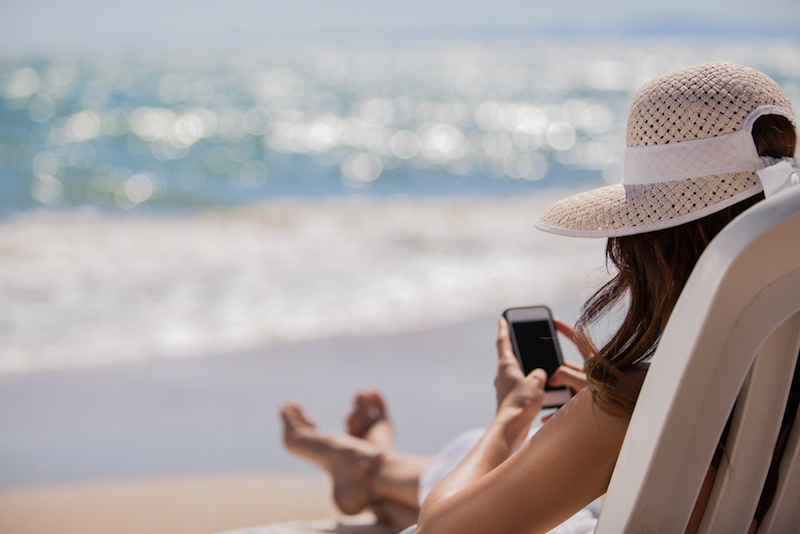Sun Protection App Works, If People Use It

Want to keep your skin wrinkle free and reduce your risk of skin cancer? A smartphone app can help, according to a pair of new studies. The trick is getting people to actually use the tool.
In two new clinical trials, researchers found that the app, called Solar Cell, encourages people to spend more time in the shade and less time in the midday sun, while also nudging them toward wearing protective, wide-brim hats. But getting people to download and use the app was tough, as it is with many health-related apps, said study leader David Buller, a research director at Klein Buendel, a health communication research organization based in Golden, Colorado.
"If you look at the general data on how apps are used, very large numbers of apps are either never downloaded or if they are downloaded, people don't use them more than once or twice," Buller told Live Science. [10 Fitness Apps: Which Is Best for You?]
Sun safety
Klein Buendel is producing Solar Cell in partnership with the National Cancer Institute. Most health-related apps undergo little to no formal testing, but Buller and his colleagues conducted two clinical trials on Solar Cell, randomly assigning participants to either use the app or not while testing their sun-protection behaviors.
The app offers personalized sun-protection advice based on real-time ultraviolet (UV) light forecasts and the user's own risk factors for sun damage, such as skin tone. Solar Cell's full version will roll out in spring 2015, Buller said. For now, users can get a free, basic version called sunZapp for Android or iOS.
Both of the studies the researchers did on Solar Cell used a randomized clinical trial design, considered the gold standard for health research. In the first study, researchers recruited 604 adults from a survey panel called the Knowledge Panel; ultimately, 454 participants completed both a pre-survey and a post-survey about their sun protection behaviors.
Sign up for the Live Science daily newsletter now
Get the world’s most fascinating discoveries delivered straight to your inbox.
About half of participants were assigned to download and use the Solar Cell app, while the other half were given no sun-related advice or treatment at all. Of the 305 people assigned to download and use the app, though, only 125 actually did.
As a result, when the researchers compared all the people assigned to use the app with those assigned not to do so, they found few differences in outcomes, except that those in the app group reported spending more time in the shade after the experiment. So the researchers zeroed in on the 125 people who downloaded the app, comparing them to the rest of the people in the app group who didn't use it.
This comparison yielded some fruit: People who used the app reported spending more time engaging in sun-protection behaviors, such as wearing protective clothing, and less time in the midday sun than those who were supposed to use the app but didn't. Interestingly, the app users also reported less sunscreen use — but that might be a good thing, Buller said. Many people use sunscreen incorrectly, and shade and indoor time are often better protection, he said.
The second study was identical, except this time, researchers made an extra effort to ensure that the participants in the study would use the app by pre-screening them and texting them regular reminders. This time, 74 of the 96 participants who were assigned to use the app actually did so.
Again, the app showed some success. Users reported wearing wide-brimmed hats at midday more often than those assigned not to use the app. Users also said they spent less time in the sun than did nonusers. But the app did not affect the likelihood of suffering sunburn.
"That was unexpected," Buller said. It may be that there were too few cases of sunburns during the eight- to 10-week studies for the app to make much of a difference, he said. [7 Common Summer Health Concerns]
Attracting app users
Both studies appear today (Jan. 28) in the journal JAMA Dermatology. The research highlights the challenge of changing people's behavior, dermatologists Dr. A. Shadi Kourosh and Dr. Joseph Kvedar of Harvard Medical School wrote in an editorial accompanying the studies in the journal.
"[A]s we use more consumer-focused interventions in an environment as personal as mobile devices, we are learning that there is a gulf between educating patients and achieving behavioral change," the dermatologists, who were not involved in the studies, wrote.
Measuring behavior change can also be difficult, Kourosh and Kvedar added. Buller and his colleagues were forced to rely on participants' self-reports, which are not always accurate.
As Solar Cell becomes widely available this spring, Klein Buendel plans to target advertising to people who spend lots of time outdoors and to dermatologists who treat skin cancer patients who may be more motivated to protect themselves against the sun, Buller said. The hope is that these vulnerable and motivated populations will get the most out of the mobile app.
Follow Stephanie Pappas on Twitter and Google+. Follow us @livescience, Facebook & Google+. Original article on Live Science.

Stephanie Pappas is a contributing writer for Live Science, covering topics ranging from geoscience to archaeology to the human brain and behavior. She was previously a senior writer for Live Science but is now a freelancer based in Denver, Colorado, and regularly contributes to Scientific American and The Monitor, the monthly magazine of the American Psychological Association. Stephanie received a bachelor's degree in psychology from the University of South Carolina and a graduate certificate in science communication from the University of California, Santa Cruz.









